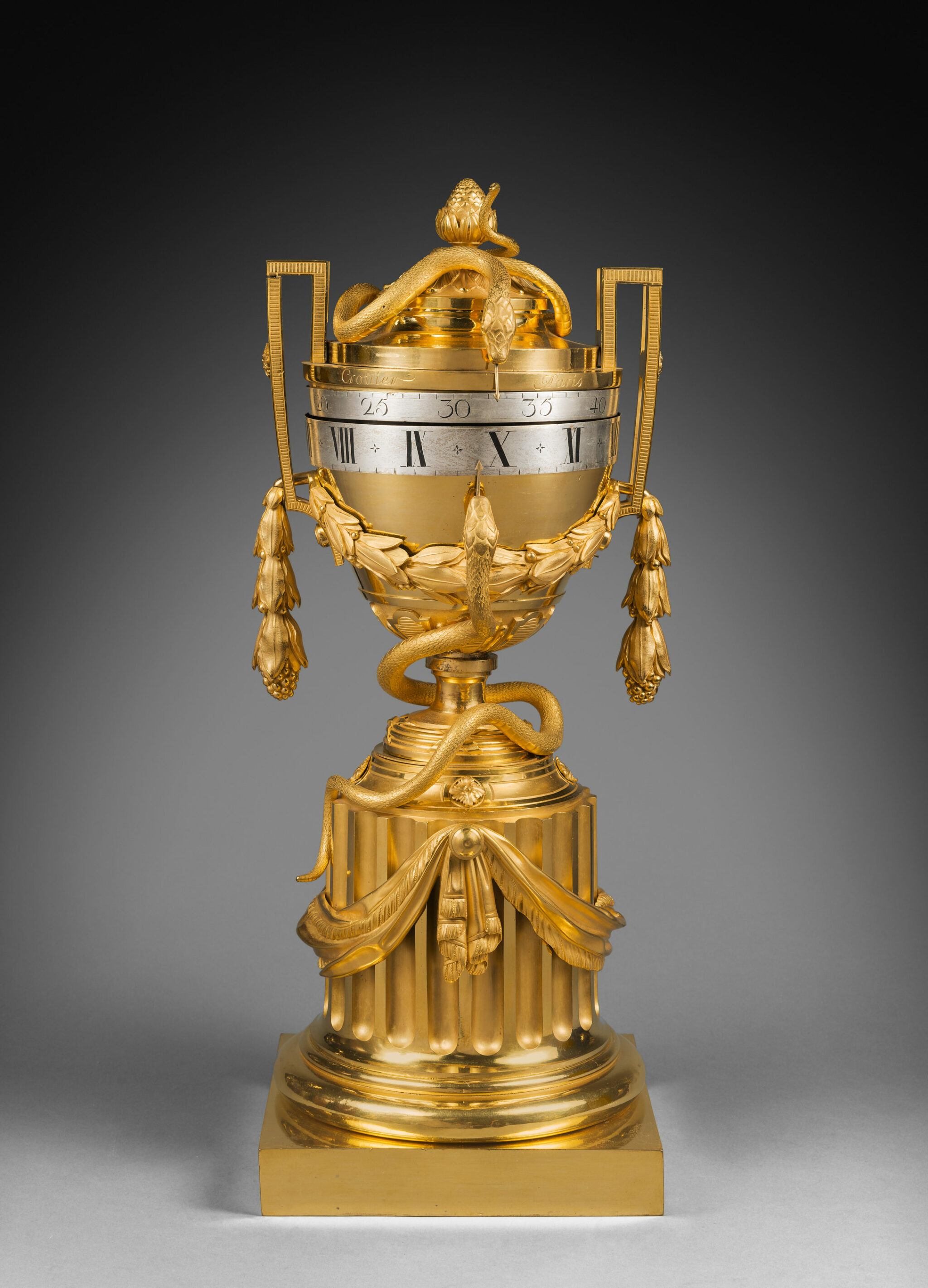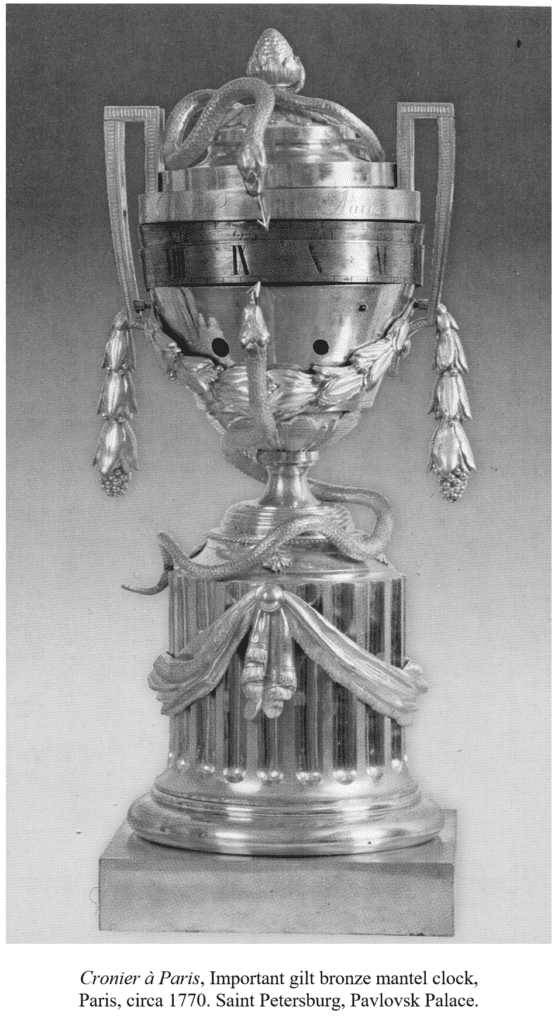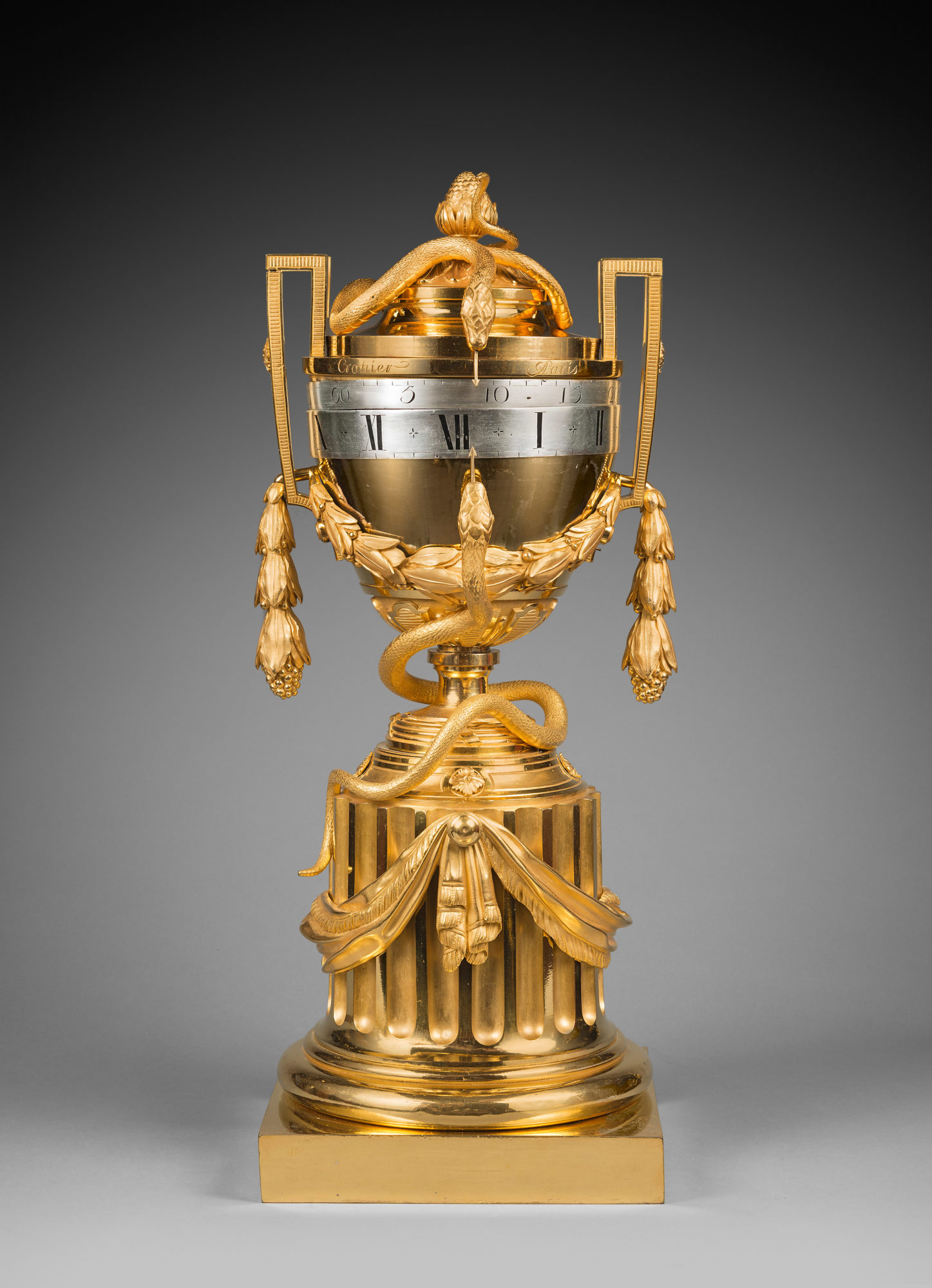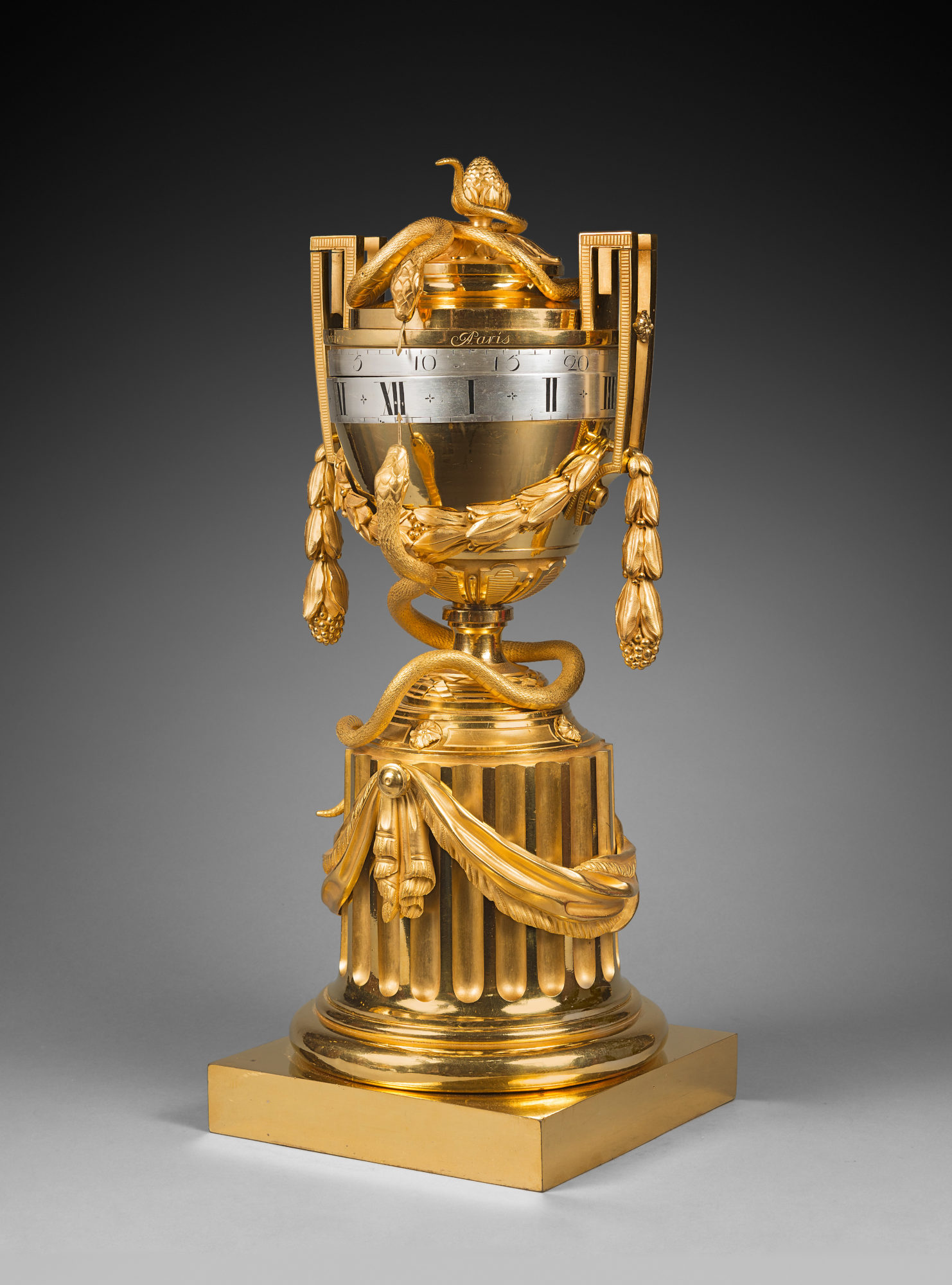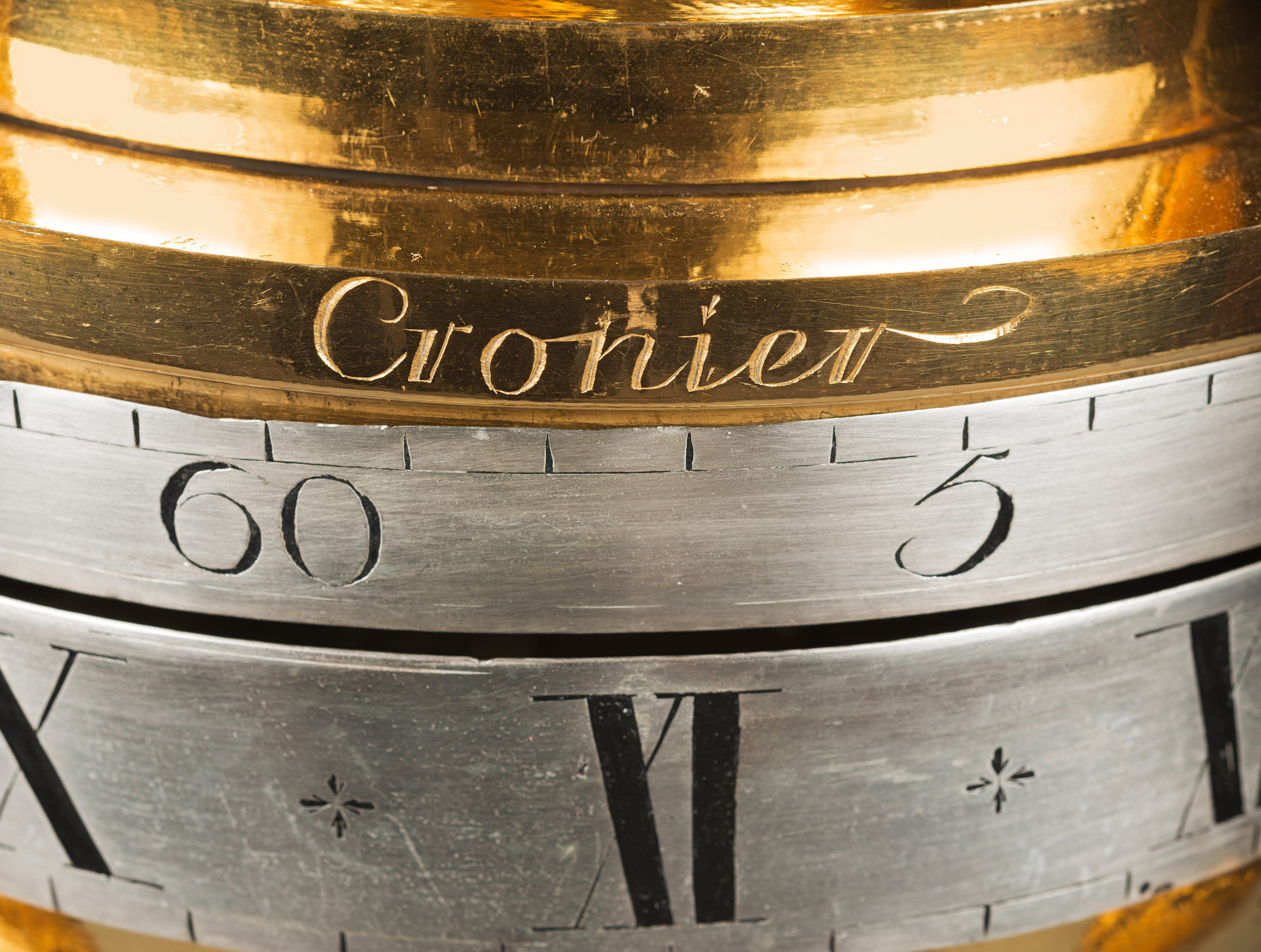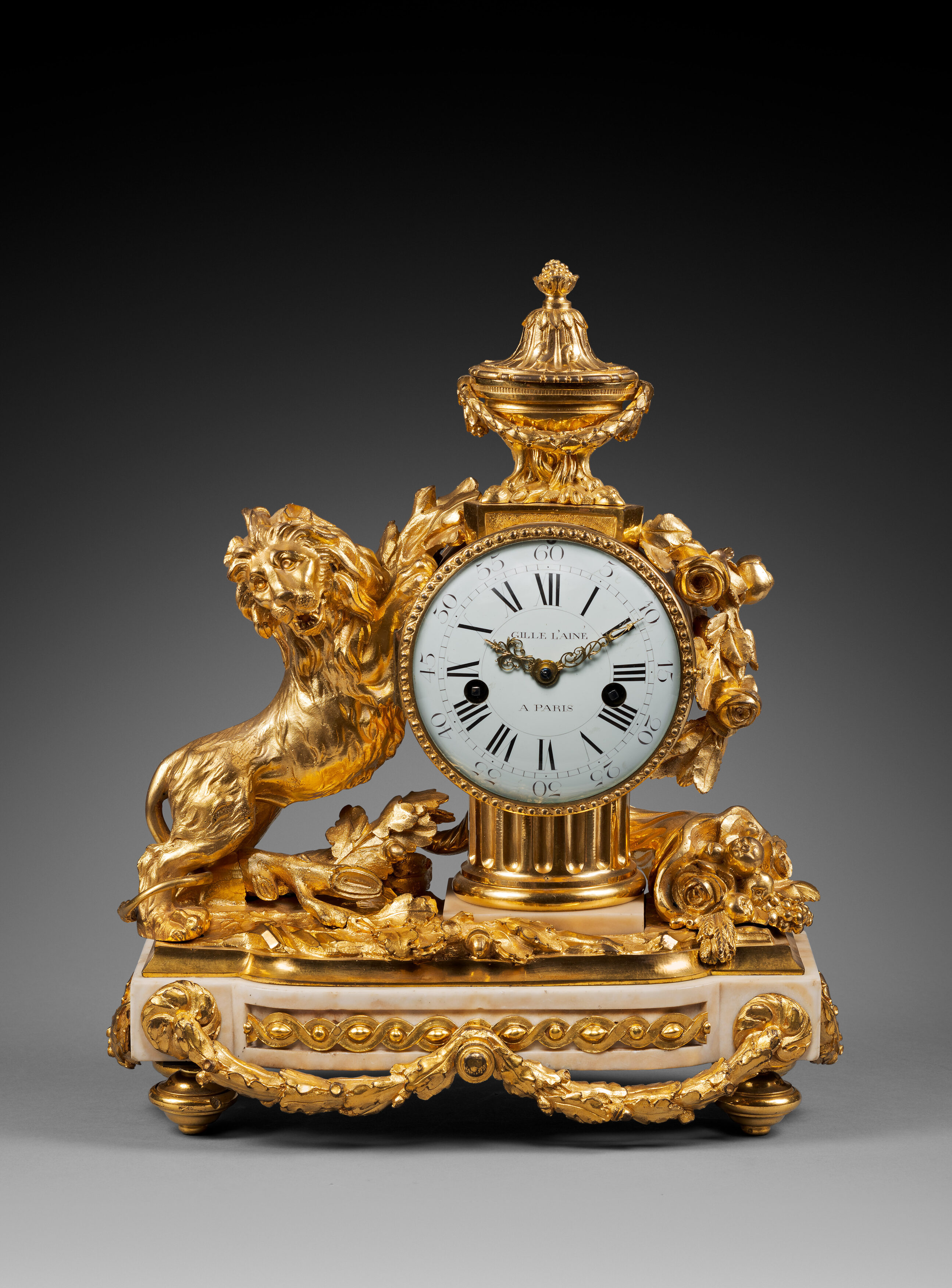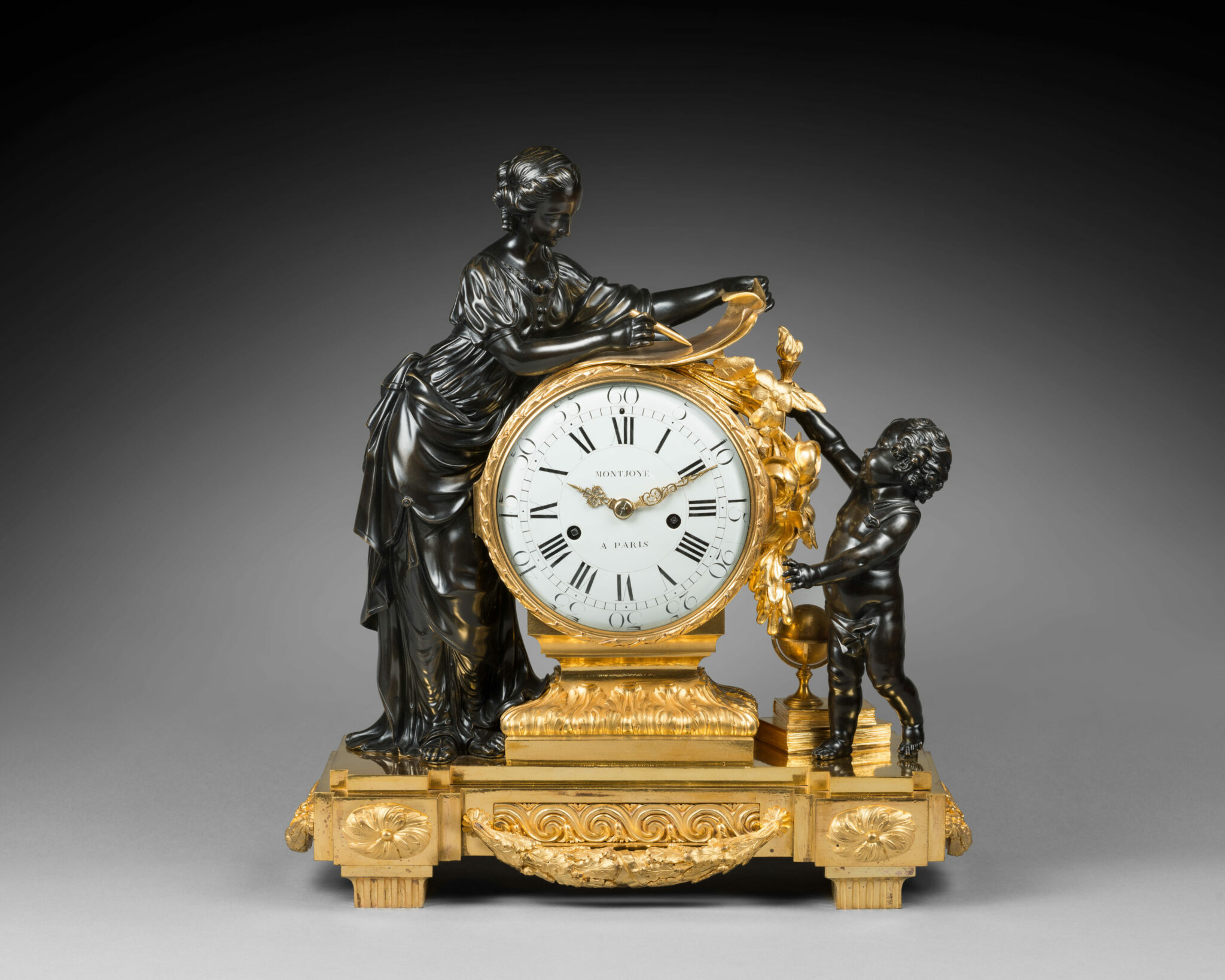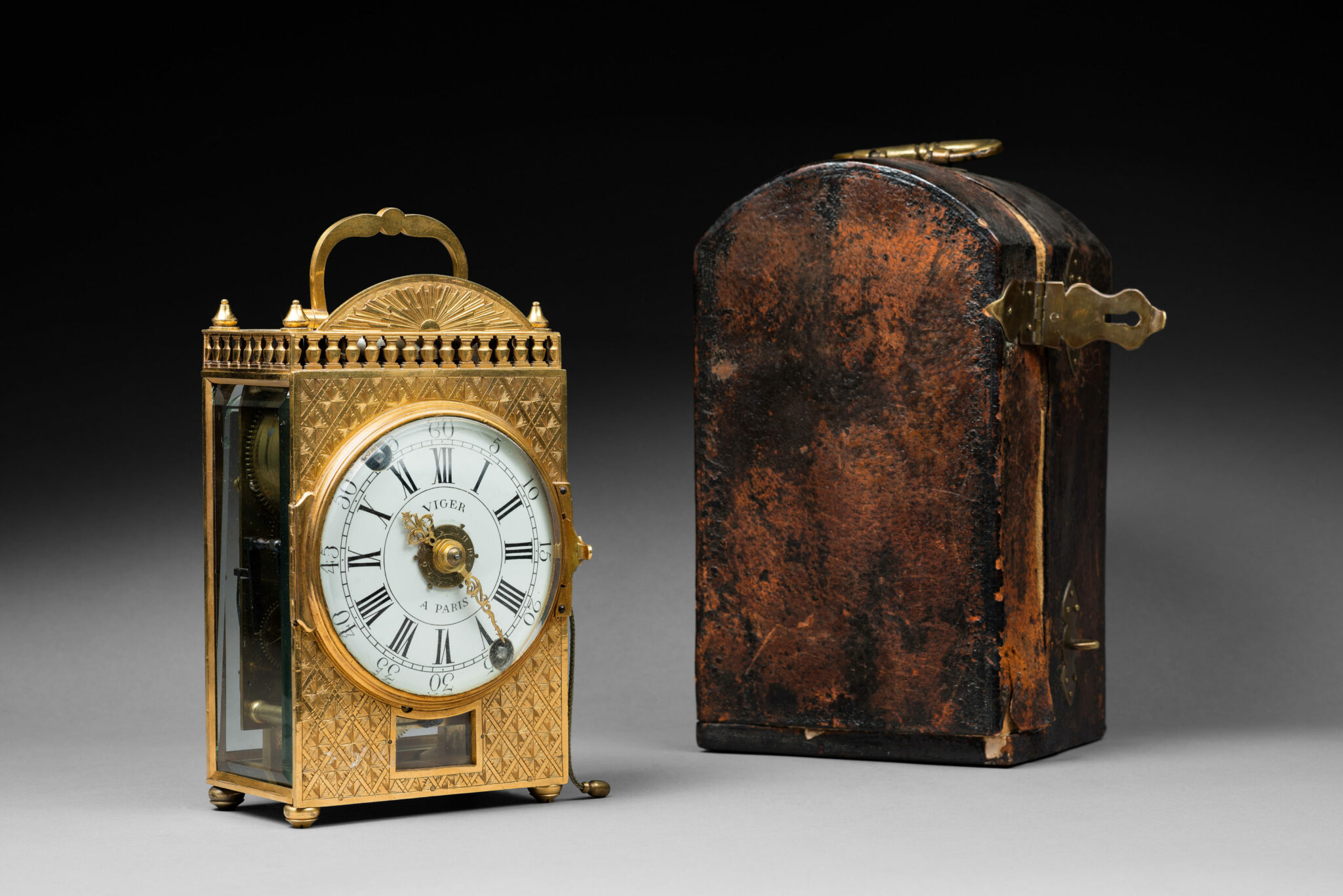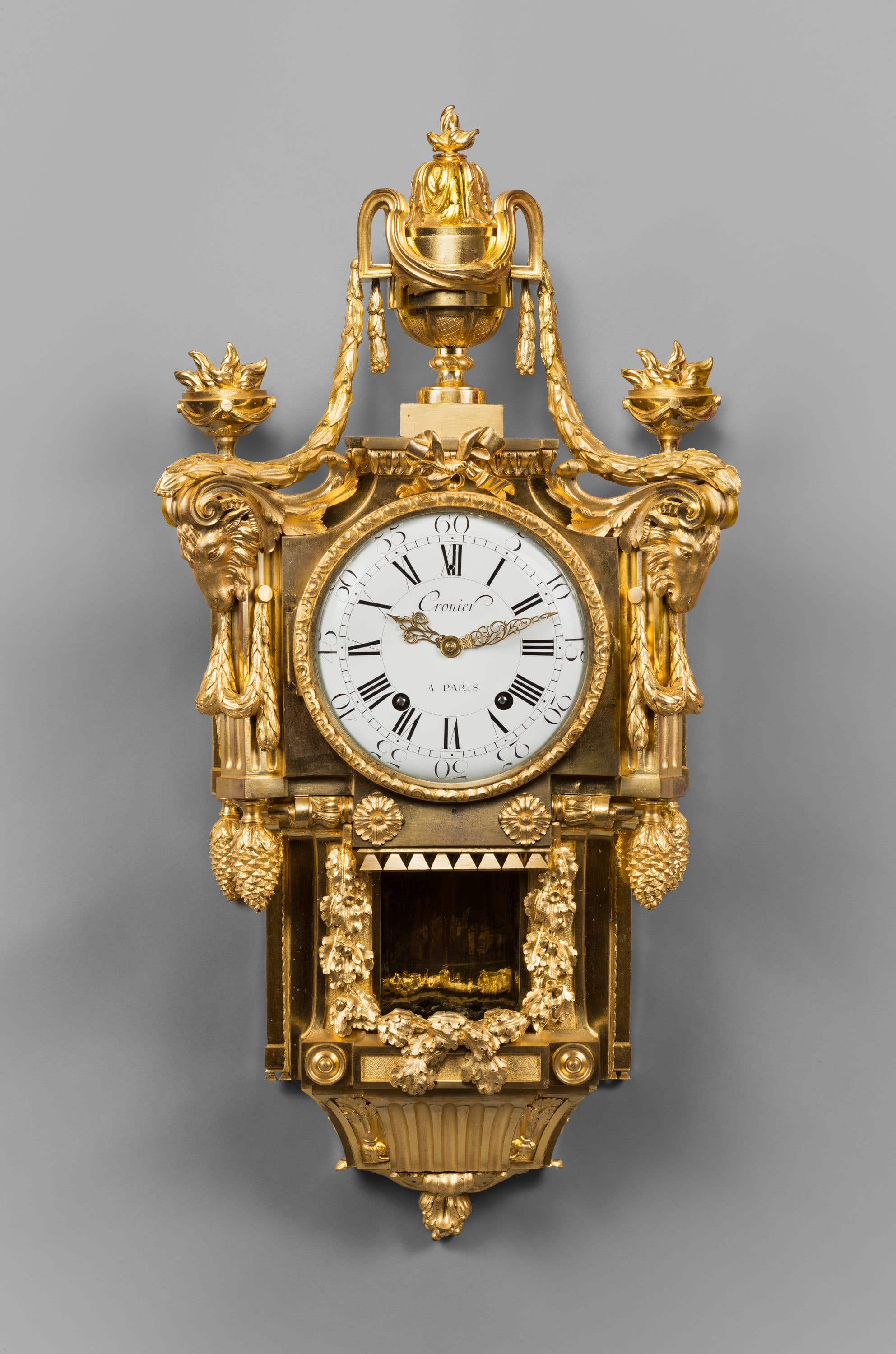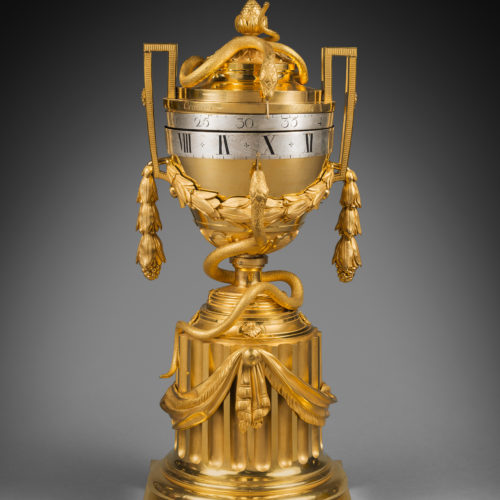Exceptional Gilt Bronze Mantle Clock in the form of a Neoclassical Lidded Vase with Matte and Burnished Finishing
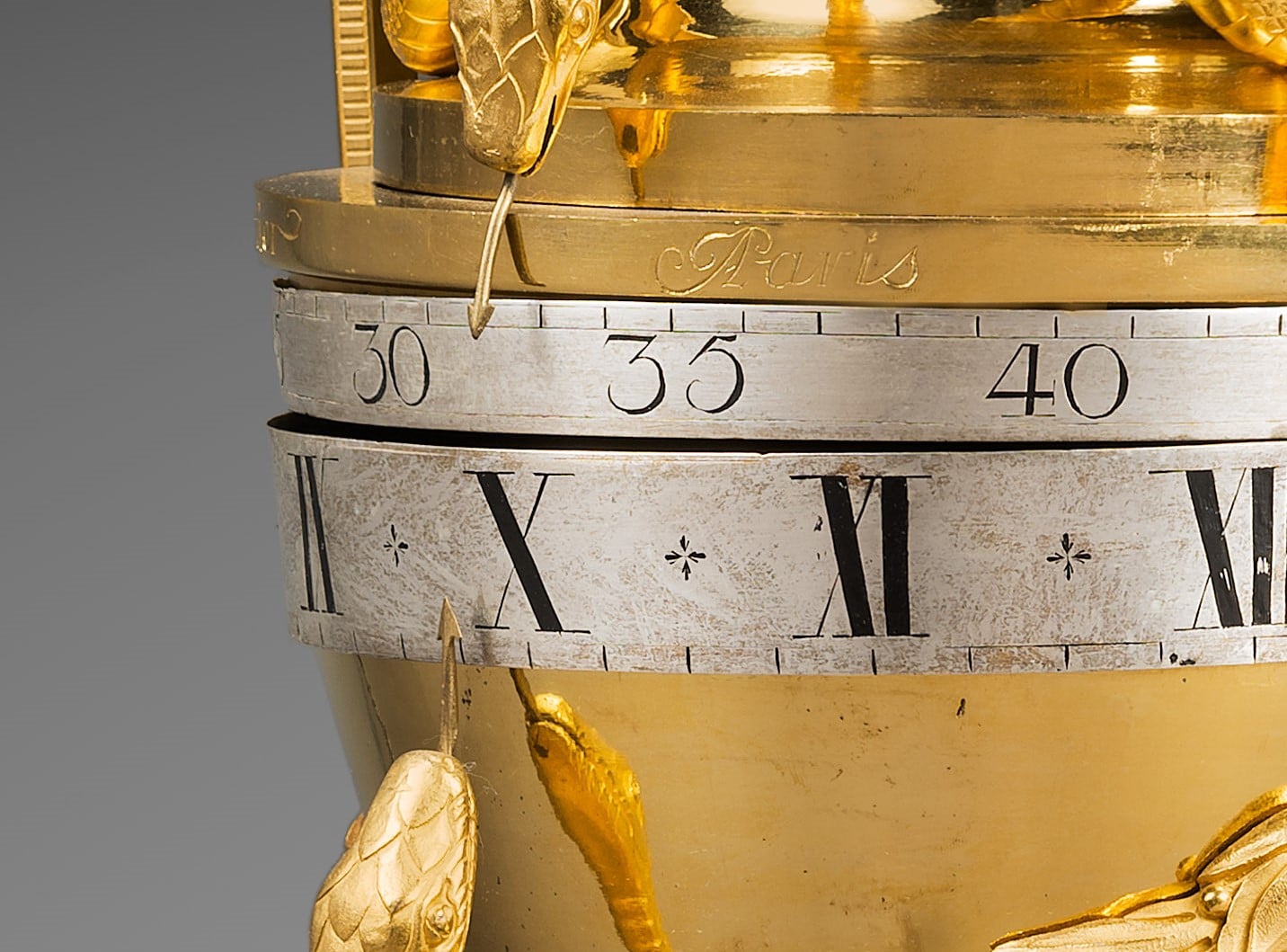
The Case Attributed to Robert Osmond
Paris, Transition period between Louis XV-Louis XVI, circa 1770
The movement is housed in a neoclassical case shaped as a classical lidded vase made of finely chased gilt bronze with matte and burnished finishing. The time is indicated by two silvered copper cercles tournants, one indicating the Arabic numeral five-minute intervals, and the other the Roman numeral hours alternating with stylized four-leaf clovers; the upper band is surmounted by the signature of the clockmaker: “Cronier à Paris”, which is engraved in the bronze. The time is indicated by the tongues of two snakes with finely chased scales, which are coiled around the body of the vase and lid. The vase has a truncated oval shape, its lid terminates in a seed finial that emerges from a bouquet of finely detailed leaves; its applied Greek handles are adorned with mille-raie patterns and a laurel-leaf swag; the lower portion of the vase, adorned with lambrequins, is supported on a molded pedestal that is decorated with ribbon-tied reeds. The base, in the form of a truncated column with wide fluting; the base, with plain toruses, features a plain torus, surmounted by a cavetto molding with reserves and rosettes. It is decorated with fringed draperies that hang from pastilles. The base is quadrangular.
Discover our entire collection of antique mantel clocks for sale online or at the gallery.
La Pendulerie is the specialist in fine and rare antique clocks, based in Paris.
The remarkable design of this important mantel clock, and the exceptional quality of its chasing, gilding, and matte and burnished finishing, offers a perfect illustration of the neoclassical decorative style that was began in the mid 18th century due to the influence of a group of important Parisian collectors, including the Count de Caylus and Ange-Laurent Lalive de Jully. The style came about as a reaction against the rococo models popular during the reign of Louis XV, which were considered to be old fashioned; the rococo style had dominated the French decorative arts for several decades. The neoclassical revival, called “a return to classicism”, was influenced by the archeological discoveries made in the ancient Roman cities of Pompeii and Herculaneum, near Naples. The fabulous discoveries that were made there continued to influence French and European decorative arts for several decades.
This is the context within which the present clock was made. Its elaborate neoclassical design, its size – very large for a “vase” type clock – and the fact that very few identical clocks are known, make it one of the most spectacular vase clocks of the period. Its design seems to have been influenced by the work of Jean-Louis Prieur, and in particular by a drawing by Prieur that is today preserved in the University of Warsaw. In addition, a vase-form clock that is adorned with figures, and whose body is quite similar to the present example, is on display in the Calouste Gulbenkian Museum in Lisbon (see H. Ottomeyer and P. Pröschel, Vergoldete Bronzen, Die Bronzearbeiten des Spätbarock und Klassizismus, Band I, Munich, 1986, p. 167). However, despite these similarities, the present clock most closely resembles several pieces by the famous bronzier Robert Osmond, who made a specialty of clocks shaped as classical vases. It is particularly close to a model in the Zähringer Museum in Baden-Baden (see P. Verlet, Les bronzes dorés français du XVIIIe siècle, Editions Picard, Paris, 1987, p. 110, fig. 131).
To the best of our knowledge, only four other identical clocks are known today: the first, signed “Lepaute”, was offered at the 19th century sale of the sumptuous collection of William, 12th Duke of Hamilton in Hamilton Palace (sold Christie, Manson & Woods, 17 June to 20 July 1882); it appears to be the one described in an important collection during the second half of the 18th century: “A vase-shaped clock, with square handles, laurel garlands on fluted columns, truncated with draperies, all in ormolu gilt bronze. Turning dial. Two snakes bearing the minutes hand. The movement is by Lepaute”. The second, whose bronze is engraved with the name of the clockmaker Furet, is illustrated in P. Kjellberg, Encyclopédie de la pendule française du Moyen Age au XXe siècle, Les éditions de l’Amateur, Paris, 1997, p. 284, fig. B. The third, which combines gilt bronze and white marble, and features several decorative variations, is in the Louvre Museum in Paris (illustrated in Tardy, La pendule française, 2ème Partie: Du Louis XVI à nos jours, Paris, 1975, p. 289, fig. 5, and in E. Niehüser, Die französische Bronzeuhr, Eine Typologie der figürlichen Darstellungen, Editions Callwey, Munich, 1997, p. 263, fig. 1292). A fourth clock of this type, which is identical to the present clock, is part of the horological collection of Pavlovsk Palace, near Saint Petersburg, formerly the summer residence of Tsar Paul I. It also bears the signature of clockmaker Antoine Cronier engraved in the bronze and has been attributed to the bronze caster Osmond (see The State Culture Preserve Pavlovsk, Full Catalogue of the Collections, Tome X, Métal-Bronze, Volume I, Clocks, regulators, cartels, Saint Petersburg, 2011, p. 24, catalogue n° 7).
Antoine Cronier (1732 - après 1806)
Antoine Crosnier, or Cronier, was one of the most important Parisian clockmakers of the second half of the 18th century. The son of a Parisian master joiner, he became a master on March 1, 1763 and opened a workshop in the rue Saint-Honoré. He quickly became very successful among influential Parisian collectors of luxury horology, and worked with the finest artisans of the time, including the cabinetmaker Jean-Pierre Latz, the bronziers François Vion and the Osmonds, and the gilder Honoré Noël. During the 18th century, several of his clocks were mentioned as belonging to the Marshal de Choiseul-Stainville, the Marquis de Sainte-Amaranthe, the Duke des Deux-Ponts and the Prince Belosselsky-Belozersky.
Discover our entire collection of rare antique clocks on La Pendulerie Paris.
Robert Osmond (1711 - 1789)
French bronze-caster Robert Osmond was born in Canisy, near Saint-Lô; he began his apprenticeship in the workshop of Louis Regnard, maître fondeur en terre et en sable, and became a master bronzier in Paris in 1746. He is recorded as working in the rue des Canettes in the St. Sulpice parish, moving to the rue de Mâcon in 1761. Robert Osmond became a juré, thus gaining a certain degree of protection of his creative rights. In 1753, he sent for his nephew in Normandy, and in 1761, the workshop, which by that time had grown considerably, moved to the rue de Macon. The nephew, Jean-Baptiste Osmond (1742-after 1790) became a master in 1764 and as of that date worked closely with his uncle, to such a degree that it is difficult to differentiate between the contributions of each. Robert appears to have retired around 1775. Jean-Baptiste, who remained in charge of the workshop after the retirement of his uncle, encountered difficulties and went bankrupt in 1784. Robert Osmond died in 1789.
Prolific bronze casters and chasers, the Osmonds worked with equal success in both the Louis XV and the Neo-classical styles. Prized by connoisseurs of the period, their work was distributed by clockmakers and marchands-merciers. Although they made all types of furnishing objects, including fire dogs, wall lights and inkstands, the only extant works by them are clocks, including one depicting the Rape of Europe (Getty Museum, California) in the Louis XV style and two important Neo-classical forms, of which there are several examples, as well as a vase with lions’ heads (Musée Condé, Chantilly and the Cleveland Museum of Art) and a cartel-clock with chased ribbons (examples in the Stockholm Nationalmuseum; Paris, Nissim de Camondo Museum). A remarkable clock decorated with a globe, cupids and a Sèvres porcelain plaque (Paris, Louvre) is another of their notable works.
Specialising at first in the rocaille style, in the early 1760’s they turned to the new Neo-classical style and soon numbered among its greatest practitioners. They furnished cases to the best clockmakers of the period, such as Montjoye, for whom they made cases for cartonnier and column clocks, the column being one of the favourite motifs of the Osmond workshop.
